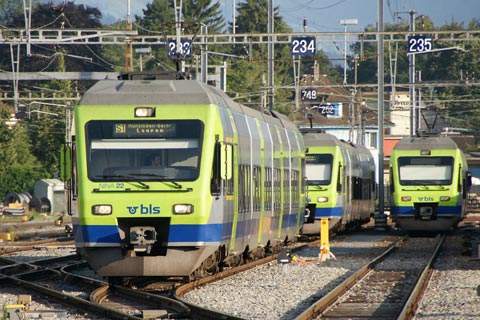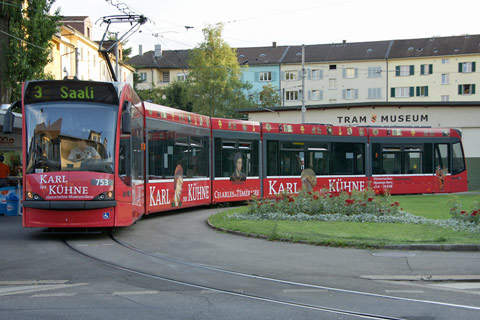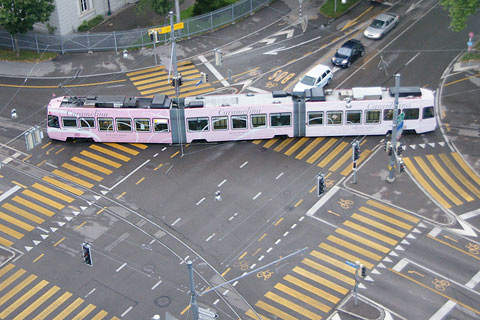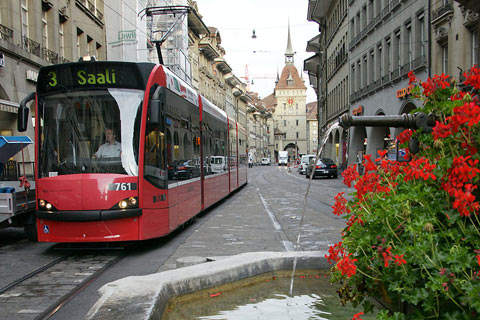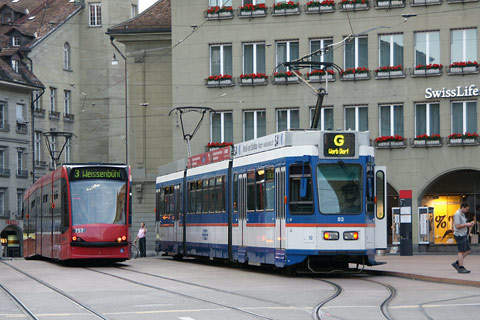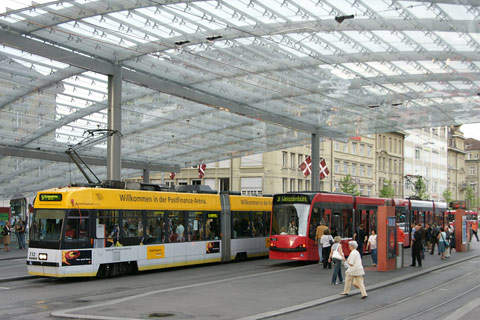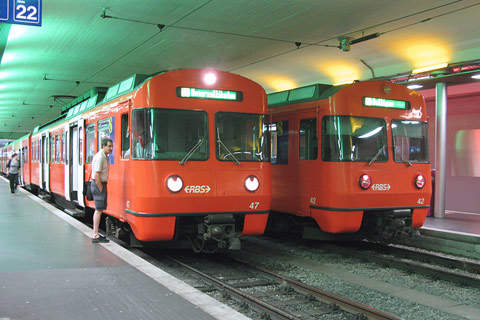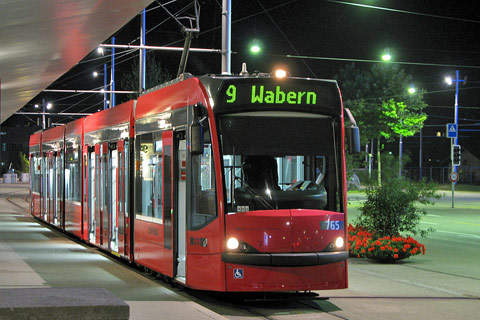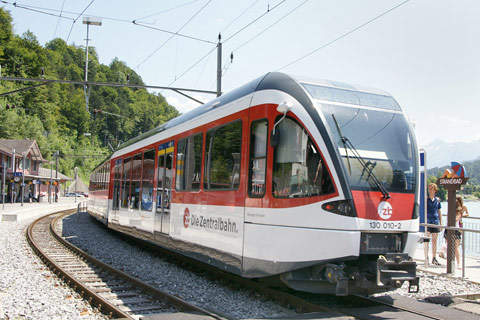The strength of the cantons in Switzerland's constitution means that Bern has a lower profile than many capital cities. It is however an important part of the national rail framework and regionally is the hub of a mixed and developing urban transport system.
Bern's city centre transport is provided by city authority Städtische Verkehrsbetriebe Bern (Bernmobil), operators of trams, buses and trolley buses. Largely owned by various bodies in the public sector, Regionalverkehr Bern-Solothurn (RBS) runs the metre-gauge S-Bahn, buses and the long-distance Line G tramway to Worb Dorf.
As part of an exchange of responsibilities with SBB taking effect in late 2004, BLS AG operates Bern's standard gauge S-Bahn network, Switzerland's second largest.
The project
Bern's tramways originated in the 1890s, growing in coverage until being cut back in favour of bus and trolleybus services. Public transport reinvestment in general began in the mid-1970s, and although reduced to three routes, the tram forms the core of the Bernmobil system in the city centre.
The Bern West project will extend tram coverage to a part of the city that is due for commercial and residential growth, currently reliant upon buses and trolley buses increasingly unable to cope with demand. Project promoters identify that new trams on order will exceed the passenger capacity of current articulated buses by 100. Stemming from city approval for funding a study in 1995 and experiencing much opposition on the way to final approval in late 2006, main construction began in April
2008.
With the project split into 33 distinct segments to minimise disruption, works should be completed by September 2010. A new line west from the city centre will branch to termini at Brünnen and Bümpliz, adding about 7km (4.4 miles) to the tram system. It is due to become operational in December 2010.
Infrastructure
Beyond the 1,435mm federal heavy rail network, in common with other Swiss tramways and most local systems, RBS and Bernmobil track is metre gauge. To enable access for SBB freight, 7km of RBS alignment north of the city is dual-gauged. All tram routes share tracks in the historical centre and past the Bahnhof, thereby the network's most intensively worked section.
The focal point for street-based public transport is Bahnhof Bern, the combined tram and bus station rebuilt as part of the wider six-year SwFr97m 'Neuer Bahnhofplatz Bern' redevelopment project. It was completed in May 2008, just before the Euro 2008 football tournament for which Bern was a host city. The overall glass canopy than covers four tram platforms was designed to provide shelter without darkening the area which is effectively the gateway to the old town.
Rolling stock
Tram routes are mainly operated by a unidirectional low-floor stock of 12 Swiss-built ABB-Vevey units and 15 Siemens Combinos. Now extended over the Aare river, unlike the Bernmobil routes which have turning loops at termini, RBS route G is bi-directional and has a dead-end terminus at Zytglogge. As well as being modified with new low-floor centre sections supplied by Stadler, route G is to gain greater integration with Bernmobil and will pass westwards through the city centre to
Fischermätteli.
RBS operates a mixed fleet of electric multiple units dating from the 1970s, retrofitted as required for low-floor access. For their S-Bahn operations, BLS Bern use a fleet of 36 140km/h RABe 525 'Nina' (Niederflur-Nahverkehrs) multiple units supplied 1998-2005 by Vevey Technologies/Bombardier.
Signalling and communications
Line-of-sight operation is used on the street running tramways. Stops feature next service information, supplemented by on-board systems. Outside of route G, RBS uses block sections and is fitted with ATP systems. Standard gauge S-Bahn uses the federal rail infrastructure. As is the Swiss norm, ticketing arrangements cover all public transport modes.
The future
Now carrying over half of the area's commuter traffic and including the important S8 Solothurn connection, the RBS rail system has outgrown its present terminus beneath Bern's main station which (unusual for Switzerland) has gated platform access to control demand.
A new terminus is scheduled to be available from 2014. The first of six new low-floor access units from Stadler is due for delivery in 2009.
To cater for the Bern West expansion and rising passenger numbers, in November 2007 Bernmobil placed a SwFr100m (€65m) order with Siemens for 21 Combino Classics for delivery 2009–2010. Not only in external appearance, the new units will differ in many ways from the earlier Combinos which had been subject to withdrawal and rebuilding due to the structural problems that affected that model.
The Classics will feature air-conditioning, improved information displays and an integral ramp for disabled passengers. With seven modules and at 42m, these will also be 11m longer than Bern's existing models.
As Bern West joins the network, the routes will be reconfigured. To further increase line capacity in the shorter term, part of the current Combino fleet is due for lengthening.

